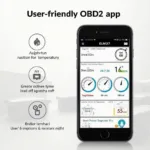Understanding how your OBD2 WiFi scanner communicates with your vehicle’s onboard computer can seem like venturing into a labyrinth of technical jargon. One of the most common questions we encounter is, “What port does my OBD2 WiFi need to listen on?”. This article aims to demystify this question and equip you with the knowledge to optimize your car diagnostic experience.
In essence, your OBD2 WiFi scanner doesn’t “listen” on a specific port in the traditional sense. Instead, it establishes a direct connection with your vehicle’s OBD2 port, typically located under the dashboard on the driver’s side. This port acts as the gateway to your car’s computer, housing a treasure trove of data about its performance, health, and potential issues.
 OBD2 WiFi Scanner Connected to Port
OBD2 WiFi Scanner Connected to Port
The magic of wireless OBD2 scanners lies in their ability to translate this complex data into a user-friendly format, accessible via your smartphone or tablet. This communication happens over a WiFi network created by the scanner itself. Once you connect your device to this network, you can utilize dedicated OBD2 apps to unlock a wealth of information about your vehicle.
Deciphering the Language of OBD2 Communication
Think of the OBD2 port as a universal language spoken by all modern vehicles. It utilizes a standardized communication protocol, ensuring compatibility across different makes and models. This protocol dictates how data is transmitted and received, ensuring seamless interaction between your scanner and your car’s computer.
However, within this universal language, there are subtle variations. The specific data points accessible and the way they are presented can differ depending on the make, model, and year of your vehicle. This is where the role of the OBD2 app becomes crucial.
A high-quality app will be able to interpret these variations, providing you with accurate and relevant information tailored to your specific car. It acts as the translator, bridging the gap between the technical language of your car’s computer and your understanding.
Troubleshooting Connection Issues
While the setup process for OBD2 WiFi scanners is generally straightforward, occasional connectivity hiccups can occur. Here are some common issues and their solutions:
-
Ensure Compatibility: Not all OBD2 scanners are created equal. Confirm that the scanner you choose is compatible with your vehicle’s make, model, and year.
-
Verify Bluetooth or WiFi Connection: Double-check that your smartphone or tablet is properly connected to the scanner’s network.
-
Check OBD2 Port Functionality: In rare cases, the issue might stem from a faulty OBD2 port. Inspect the port for any visible damage or loose connections.
-
Update App and Firmware: Regularly update both your OBD2 app and the scanner’s firmware to ensure optimal performance and compatibility.
By following these troubleshooting tips, you can overcome common connectivity hurdles and fully leverage the diagnostic power of your OBD2 WiFi scanner. Remember, a seamless connection paves the way for a deeper understanding of your car’s inner workings.
Conclusion
Navigating the world of OBD2 WiFi scanners doesn’t have to be a daunting task. Understanding that your scanner connects directly to the OBD2 port and communicates wirelessly with your device is key. By choosing a compatible scanner and a reliable OBD2 app, you can unlock a wealth of information about your vehicle’s performance, health, and potential issues.
Remember, knowledge is power. Equip yourself with the right tools and information to take control of your car’s well-being.

